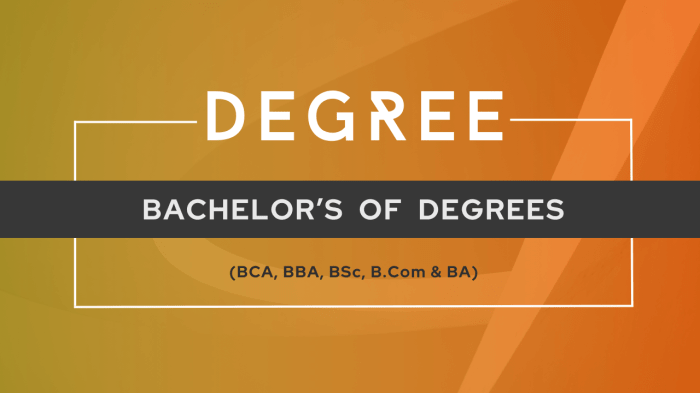Degree importance in today’s evolving job market cannot be overstated. In an era where competition is fierce and qualifications are paramount, obtaining a degree serves as a key that unlocks countless opportunities. The value of higher education extends beyond mere employment; it enriches personal growth and enhances critical thinking skills, preparing individuals for the complexities of the modern workforce.
Moreover, statistics reveal that degree holders enjoy significantly higher employment rates compared to those without a degree. This trend illustrates the long-term benefits of higher education, making it an investment worth considering for anyone looking to secure a prosperous future.
The Importance of a Degree

In an increasingly competitive job market, the importance of obtaining a degree cannot be overstated. As industries evolve and the demand for skilled professionals rises, higher education serves as a vital foundation for career success. A degree not only equips individuals with specialized knowledge and skills but also significantly enhances their employability prospects in various fields.The value of a degree extends far beyond immediate employment opportunities.
It often correlates with higher lifetime earnings, providing graduates with a financial advantage over their non-degree counterparts. According to the U.S. Bureau of Labor Statistics, individuals with a bachelor’s degree earn approximately 65% more per week than those with only a high school diploma. This wage gap illustrates the long-term benefits of higher education, as degree holders tend to experience less unemployment and greater job security during economic downturns.
Employment Rates Among Degree Holders
Understanding the employment landscape reveals significant disparities between degree holders and non-degree holders. The following statistics underscore the advantages of possessing a degree in today’s economy:
- As of 2022, the unemployment rate for individuals with a bachelor’s degree was approximately 2.2%, compared to 3.7% for those without a degree.
- Research indicates that nearly 30% of job openings require a bachelor’s degree or higher, highlighting the necessity of higher education for many professional roles.
- A study by Georgetown University predicts that by 2027, 70% of jobs will require postsecondary education, underscoring the critical need for advanced qualifications.
These figures illustrate the growing divide between those who pursue higher education and those who do not. Employers increasingly prioritize educational credentials, leading to a more favorable job market for degree holders. Therefore, investing in a degree not only opens doors to various career pathways but also significantly enhances one’s overall professional trajectory.
In colder climates, effective warmth retention is crucial, making rooftop heating solutions for colder climates an essential consideration. These innovative systems not only improve comfort but also enhance energy efficiency, allowing homeowners to enjoy their spaces during the winter months without excessive heating bills. By integrating modern technologies, we can ensure that rooftops serve as effective barriers against the chill.
“The degree is not just a piece of paper; it is a gateway to opportunities and a symbol of perseverance and dedication.”
The long-term benefits of obtaining a degree are evident through comprehensive analyses of employment trends and salary benchmarks. Graduates are more likely to advance in their careers, enjoy job satisfaction, and contribute positively to their communities. Overall, a degree holds immense value in shaping a successful future in an ever-evolving job market.
Different Types of Degrees

The landscape of higher education is diverse, featuring various types of degrees that cater to different academic and professional aspirations. Understanding these degrees is crucial for prospective students as they navigate their educational paths. Each degree type serves specific purposes and opens doors to unique career opportunities.The degrees commonly pursued in higher education include Associate, Bachelor’s, Master’s, and Doctorate degrees.
Each serves distinct academic purposes and has varying requirements that can influence a student’s decision on their educational journey.
Associate Degree
An Associate degree typically requires two years of study and is often offered by community colleges and technical schools. This degree provides foundational knowledge and skills in various fields and is a stepping stone for many students pursuing higher education.
- Fields of Study: Common areas include nursing, business administration, information technology, and criminal justice.
- Duration: Generally completed in 60 credit hours over two years.
- Requirements: A high school diploma or equivalent is necessary for admission. Some programs may require specific entrance exams or prerequisites.
Bachelor’s Degree
A Bachelor’s degree represents a more comprehensive level of education, typically requiring four years of full-time study. It is essential for many professional careers and often serves as a prerequisite for advanced degrees.
- Fields of Study: Popular disciplines include psychology, engineering, biology, and business management.
- Duration: Usually entails around 120 credit hours over four years.
- Requirements: Admission typically requires a high school diploma, standardized test scores (like SAT or ACT), and completion of specific courses during high school.
Master’s Degree
A Master’s degree is an advanced degree that usually requires an additional one to three years of study beyond a Bachelor’s. This degree allows students to specialize in their field and often leads to enhanced career opportunities and higher salaries.
- Fields of Study: Common options include education, business (MBA), public health, and engineering.
- Duration: Typically requires 30 to 60 credit hours over one to two years.
- Requirements: Generally requires a Bachelor’s degree, letters of recommendation, and a statement of purpose. Some programs may also require standardized test scores (like GRE or GMAT).
Doctorate Degree
A Doctorate degree represents the highest level of academic achievement and usually requires several years of study and original research. This degree prepares graduates for careers in academia, research, and highly specialized fields.
- Fields of Study: Common disciplines include philosophy (Ph.D.), education (Ed.D.), and various professional doctorates in fields like medicine (M.D.) and law (J.D.).
- Duration: Often requires four to six years of study beyond a Master’s degree, including the completion of a dissertation or significant project.
- Requirements: A Master’s degree is typically required for admission, along with a strong academic record, research proposal, and relevant standardized test scores.
“Higher education degrees not only open doors to career opportunities but also serve as a testament to personal discipline and commitment.”
The Process of Earning a Degree
Earning a degree is a structured journey that involves several key steps, from choosing a program to completing all necessary requirements. This process can vary based on the type of degree and the institution, but generally follows a clear pathway. Understanding this process is crucial for prospective students who wish to navigate their academic pursuits successfully.
As we look towards a more sustainable future, integrating solar panels into rooftop designs for a greener future becomes increasingly important. This synergy not only harnesses renewable energy but also reduces the carbon footprint of urban environments. By embracing such eco-friendly innovations, we can create rooftops that contribute positively to the ecosystem while meeting energy needs efficiently.
Steps Involved in Applying to a Degree Program
The application process can seem daunting, but it can be broken down into manageable steps. This clarity helps prospective students approach their applications with confidence and precision.
- Research Programs: Identify degree programs that align with your career goals and interests.
- Prepare Application Materials: Gather necessary documents, such as transcripts, letters of recommendation, and personal statements.
- Complete Application Forms: Fill out the application forms accurately, ensuring all information is complete.
- Submit Applications: Send in your application before the deadline, often accompanied by an application fee.
- Prepare for Interviews: Some programs may require interviews, so be ready to articulate your goals and motivations.
- Receive Acceptance Letters: After a waiting period, you’ll receive decisions from the institutions to which you applied.
- Finalize Enrollment: Accept an offer and follow the institution’s instructions for enrollment, including securing financial aid if applicable.
Necessary Prerequisites and Preparations for Enrollment
Before enrollment, certain prerequisites and preparations can enhance your academic readiness and ensure a smoother transition into college life. Recognizing these requirements is essential for success.
“Preparation today leads to success tomorrow.”
Key prerequisites often include:
- High School Diploma or Equivalent: Most degree programs require a secondary education credential.
- Standardized Test Scores: Depending on the program, tests such as the SAT or ACT may be needed.
- Background Knowledge: Some programs may expect familiarity with specific subjects, especially in technical fields.
- Financial Planning: Understanding tuition costs and exploring scholarship opportunities are vital steps.
Timeline for a Typical Degree Program from Start to Finish
The timeline for completing a degree program varies based on the type of degree and the institution’s structure. A clear timeline can help students manage their academic journey effectively.A typical timeline for a bachelor’s degree program, for instance, can be Artikeld as follows:
| Phase | Duration |
|---|---|
| Preparation and Application | 6-12 months |
| Enrollment and Orientation | 1 month |
| Coursework Duration | 3-4 years |
| Internship/Practicum (if applicable) | 1 semester |
| Capstone Project or Thesis (if required) | 1 semester |
| Graduation | 1 month |
This structured timeline aids students in pacing their studies and fulfilling all requirements timely, ultimately leading to a successful graduation and readiness for the workforce or further education.
Online Degrees vs. Traditional Degrees
In an increasingly digital world, the choice between online degrees and traditional degrees has become a pivotal decision for many students. Online learning offers flexibility and convenience, while traditional education often provides a structured environment with direct interactions. Understanding the differences, advantages, and challenges of both formats is essential for anyone considering further education.The evolution of education has been significantly influenced by technological advancements, especially the rise of online degree programs.
This shift allows individuals to pursue higher education from anywhere, catering to diverse learning styles and schedules. However, the traditional classroom experience offers benefits that online formats may lack, such as immediate feedback and networking opportunities with peers and instructors.
Pros and Cons of Online Learning and In-Person Education
Both online and traditional degrees come with their respective strengths and weaknesses. Evaluating these can help students make informed choices based on their personal circumstances.
- Flexibility: Online degrees provide scheduling flexibility, allowing students to learn at their own pace without the constraints of a fixed timetable.
- Accessibility: Online education opens doors for those who may have geographic, financial, or personal constraints that limit their ability to attend a physical campus.
- Cost-Effectiveness: Online programs often have lower tuition fees and eliminate commuting costs.
- Networking Opportunities: Traditional degrees offer face-to-face interactions, fostering stronger relationships with professors and peers that can be beneficial for future career opportunities.
- Hands-On Learning: Certain disciplines, such as medicine or engineering, require hands-on experience that is often best obtained through in-person courses.
Popular Online Degree Programs
The demand for online education has surged, leading to a variety of programs designed to meet the needs of different learners. Some of the most popular online degree programs include:
- Business Administration: MBA programs online are among the most sought after, catering to professionals seeking to elevate their career prospects.
- Computer Science: With the rise of technology, degrees in computer science and information technology have seen a significant increase in enrollment.
- Nursing: Many nursing programs offer online coursework, combined with clinical experiences in-person, accommodating working professionals.
- Education: Online teaching degrees are popular for educators looking to advance their qualifications while maintaining current teaching positions.
- Criminal Justice: Online degrees in criminal justice attract students interested in pursuing careers in law enforcement, legal studies, or homeland security.
Impact of COVID-19 on Online Education Perceptions
The COVID-19 pandemic has dramatically reshaped perceptions of online education. As institutions were forced to pivot to remote learning, many students and educators experienced the benefits and challenges of this format firsthand.
The pandemic highlighted the necessity of adaptable learning environments, making online education not just an alternative but a viable and often preferred option.
As a result, numerous individuals who may have been skeptical of online learning have now recognized its potential for delivering quality education. Moreover, the increase in technological investments by educational institutions has led to enhanced online learning platforms, fostering a more engaging and interactive experience.Overall, the ongoing changes in educational modalities, driven by both necessity and innovation, continue to reshape how degrees are perceived and pursued.
Financing a Degree

The financial aspect of earning a degree can be daunting for many students. Understanding the various financing options available is crucial in navigating the costs associated with higher education. Fortunately, there are multiple avenues for funding a degree, each with its own benefits and challenges. Various methods exist to help students cover the expenses of their education, including scholarships, grants, and loans.
Scholarships and grants are often the most desirable options, as they do not require repayment. Loans, while sometimes necessary, can lead to significant debt post-graduation if not managed carefully.
Funding Options for Education
Students should be aware of the different types of financial aid available to them and their eligibility criteria. The following table summarizes various funding options, highlighting their key features:
| Type of Aid | Description | Repayment |
|---|---|---|
| Scholarships | Financial awards based on merit, need, or specific criteria. | No repayment required. |
| Grants | Need-based financial aid that does not need to be repaid. | No repayment required. |
| Federal Student Loans | Loans provided by the government with flexible repayment options. | Repayment required with interest. |
| Private Student Loans | Loans offered by private lenders, often with higher interest rates. | Repayment required with interest. |
Managing education expenses effectively can significantly alleviate financial burdens. Here are some tips that can assist in budgeting for educational costs:
- Develop a comprehensive budget that includes tuition fees, textbooks, supplies, and living expenses.
- Explore all scholarship opportunities early and apply to as many as possible to increase chances of funding.
- Utilize community college courses or online classes, which often cost less per credit hour, as a means to reduce overall education expenses.
- Consider working part-time while studying to help cover living costs and minimize reliance on loans.
- Keep track of all financial aid applications and deadlines to ensure no opportunities are missed.
“Understanding your financial options can empower you to make informed decisions about funding your education.”
In summary, financing a degree requires careful consideration and planning. By leveraging scholarships, grants, and loans judiciously, students can manage their education expenses more effectively and reduce potential financial strain after graduation.